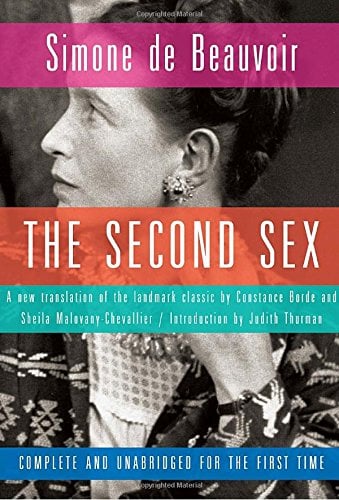The Woman Destroyed by Simone de Beauvoir
By Nava Atlas | On March 29, 2019 | Updated September 8, 2022 | Comments (0)

The Woman Destroyed by Simone de Beauvoir (1908 – 1986) published first in French in 1967 as La Femme Rompue, presents a trio of novellas (or, one could argue, long short stories).
The French author, existential philosopher, political activist, and feminist has remained best known for The Second Sex (1949). But de Beauvoir also put her social theories, especially those pertaining to affairs of the heart, into several works of fiction.
Upon the book’s 1969 publication in English, The Sunday Herald Times (London) wrote: “In three immensely intelligent stories about the decay of passion, Simone de Beauvoir draws us into the lives of three women, all past their first youth, all facing unexpected crises … suffused with de Beauvoir’s remarkable insights into women, The Woman Destroyed gives us a legendary writer at her best.”
. . . . . . . . .

See also: The Second Sex by Simone de Beauvoir
. . . . . . . . .
ThoughThe Woman Destroyed was generally praised, not all reviewers were as enthusiastic as the one above. Following is a review of the American edition that, though critical of the book’s tone, nonetheless offers a succinct synopsis of each story:
The Woman Destroyed: Three Women in Crisis
From a review by Inna Uhlig of The Woman Destroyed by Simone de Beauvoir in The Baltimore Sun, March 23, 1969: In this English translation of La Femme Rompue, Simone de Beauvoir presents three novellas, or long short stories, that describe women over forty, each delving into her own unhappiness:
The Age of Discretion
In “The Age of Discretion,” the woman is faced with a young married son who suddenly tears himself free from her sphere of influence. She rejects him completely, refusing to see him. At the same time, she observes that she no longer seems to bring her husband any kind of happiness. She and he are not in accord over her treatment of their son.
As her marital relationship shifts into a different key, she and her spouse grow father and farther apart. At the end there is a suggestion of a new plateau of understanding, but it’s not convincing because non of the problems have been resolved.
. . . . . . . . . .

Learn more about Simone de Beauvoir
. . . . . . . . . .
The Monologue
In the middle tale, the tone is strident, the pitch continuously noisy, rising over and over again to a hysterical note. “The silly bastards!” the woman cries at the first gasp. Her accusing, despairing monologue goes on and on about the ghastly mess in which she is drowning: a woman separated from her child and “ditched” by his “swine of a father.”
She screams how she is rotting all alone, how she is being trampled underfoot. She moans that she is “bored through the ground,” alone on New Year’s Eve.
And then, there is the memory of her daughter, dead by her own hand at fifteen. She vows she would have made that daughter into a fine girl, asking nothing, only giving. When they buried their daughter, she cries out that they really buried her. The woman gives one scream after another of rage and despair and loneliness, until there is more than enough.
The Woman Destroyed
The title story, “The Woman Destroyed,” is told in a more modified tone; but the undercurrent of despair builds to uncontrolled proportions. In this monologue, the woman tells of a comfortable life that is being washed away by her husband’s affair with another woman.
The woman telling her story has two grown daughters, one of whom is married and the other pursuing an independent career in the United States. Now, as her unhappiness builds, she even questions her upbringing of her daughters.
Alone with her husband, she gradually becomes aware of his concealments and actual lies that hide the fact that he is not really “eaten up by his profession”
Running from friend to friend, the wife becomes less and less sure of herself as she allows her husband to share his life with the other woman. Where everything had been secure and tidy, suddenly everything is disintegrating.
Having devoted her whole self to her family, the wife fines herself faced with an utterly abandoned life. she is playing a losing game.
This reviewer’s conclusion
Each of these novellas is concerned with a desperately unhappy, no-longer-young woman whose life is going down the drain. Three such monologues, in succession, are an overdose. At the same time, none of the husbands or other characters in any of the stories take on a convincing life of their own.
What we have are three female voices, one louder and more strident than the other, but all disconcerting. None of them throw any real light upon the melancholy situations complained about.
. . . . . . . . . .

. . . . . . . . . .
A contemporary coda to A Woman Destroyed
Though the reviewer above gives helpfully neat synopses of these stories, it’s evident that the she found the characters distasteful. Scanning recent reader reviews, contemporary readers find much in this book that resonates.
On the book’s discussion page on Goodreads, one reader notes, “Reading The Woman Destroyed, I was reminded that all great writing is a warning, or at the very least, veiled advice on how one might attempt to live a meaningful life.”
Another writes, “Her characters make sense of life on the page and when they discover the why in the actions of others, the reader is invited along for the journey.”
Despite the brevity of the book, many readers, both female and male, leave long, thoughtful musings on how the book has resonated with them. It could be that Simone de Beauvoir was tapping into a fictional form of confessional angst that was a bit before its time, and that has aged well.
Quotes from The Woman Destroyed
“Tragedies are all right for a while: you are concerned, you are curious, you feel good. And then it gets repetitive, it doesn’t advance, it grows dreadfully boring: it is so very boring, even for me.”
. . . . . . . . . .
“My life was hurrying, racing tragically toward its end. And yet at the same time it was dripping so slowly, so very slowly now, hour by hour, minute by minute. One always has to wait until the sugar melts, the memory dies, the wound scars over, the sun sets, the unhappiness lifts and fades away.”
. . . . . . . . . .
“Fathers never have exactly the daughters they want because they invent a notion a them that the daughters have to conform to.”
. . . . . . . . . .
“It is dark: I cannot see myself anymore. And what do the others see? Maybe something hideous.”
. . . . . . . . . .
“What an odd thing a diary is: the things you omit are more important than those you put in.”
. . . . . . . . . .
“Some things I loved have vanished. A great many others have been given to me.”
. . . . . . . . . .
“Even if one is neither vain nor self-obsessed, it is so extraordinary to be oneself – exactly oneself and no one else – and so unique, that it seems natural that one should also be unique for someone else.”
. . . . . . . . . .
“It is so tiring to hate someone you love.”
. . . . . . . . . .
“A couple who go on living together merely because that was how they began, without any other reason: was that what we were turning into?”
. . . . . . . . . .

You might also enjoy: She Came to Stay by Simone de Beauvoir
Leave a Reply